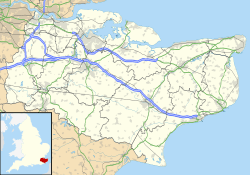Tonbridge Priory facts for kids

Remains of the Priory in 1735
|
|
| Monastery information | |
|---|---|
| Established | 1124 |
| Disestablished | 1525 |
| Dedicated to | St Mary Magdalene |
| Diocese | Rochester |
| People | |
| Founder(s) | Richard Fitz Gilbert de Clare |
| Site | |
| Location | Tonbridge, Kent |
| Coordinates | 51°11′33″N 0°16′19″E / 51.19250°N 0.27194°E |
| Visible remains | None |
| Other information | Site obliterated by the building of Tonbridge railway station and associated infrastructure in 1842. |
Tonbridge Priory was a special kind of monastery called a priory. It was located in Tonbridge, Kent, England. This priory was started way back in 1124. Sadly, a big fire destroyed it in 1337, but it was rebuilt. The priory was officially closed down in 1523. The building was still standing in 1735, but by 1780, it was just a ruin. The last parts of the priory were taken down in 1842. This happened when the South Eastern Railway built the train tracks through Tonbridge. The first Tonbridge train station was even built right on its old site!
Contents
The Priory's Beginnings
Tonbridge Priory was founded in 1124 by Richard Fitz Gilbert de Clare. He was an important person who owned Tonbridge Castle. When he passed away in 1136, he was buried right there in the priory.
In 1191, Pope Celestine III sent an important message called a Papal bull. This message gave the priory some special rights. They could get two cartloads of wood every day. They also had the right to let 80 pigs eat acorns in the forest. Plus, they were given a buck every year for the Feast of St Mary Magdalene.
The priory was named after St. Mary Magdalene. It was an Augustinian priory, which means it followed the rules of the Augustinian order. It had many buildings, including:
- a chapter house (where meetings were held)
- a church (for worship)
- a dormitory (where the monks slept)
- a library (for books)
- a refectory (for eating meals)
- a vestry (where robes were kept)
In 1267, the priory was given control of the local parish church in Tonbridge. Imagine a Christmas feast at the priory during the time of King Edward I! They had beef, beer, bread, chickens, hams, herrings, pigs, and wine.
Fire, Rebuilding, and Important Burials
On July 11, 1337, a terrible fire destroyed the priory. But people helped to rebuild it! The Bishop of Rochester and the Archbishop of Canterbury offered their support. They allowed the priory to use the money from the church and vicarage in Leigh. This money, about £12 a year, was used to help two canons (monks) and rebuild the priory.
Many important people were buried at the priory:
- In 1342, Margaret de Clare was buried there.
- Her husband, Hugh de Audley, was also buried there in 1347.
- In 1349, their daughter, Margaret de Audley, was buried at the priory.
- Her husband, Ralph de Stafford, was buried there in 1372.
- Later, William Stafford, 4th Earl of Stafford was also buried here.
In 1348, the head of the priory, called the Prior, even loaned King Edward III £4 to help him fight the French.
Priory Life and Its End
The priory also owned its own mill, called Priory Mill. This mill helped them grind grain.
In 1523, a powerful leader named Cardinal Wolsey suggested closing the priory. He wanted to sell 40 priories and monasteries to raise money. This money would be used to start a new college called Christ Church in Oxford. At that time, Tonbridge Priory was valued at about £48.
The priory was officially closed on February 8, 1525. Cardinal Wolsey had promised to open a free grammar school for 40 students in Tonbridge if the priory closed. But the people of Tonbridge did not want their priory to close! They wanted it to stay open. Even after Wolsey's death in 1530, the issue was still not settled. The priory then became property of the Crown. It wasn't until 1553 that Andrew Judde finally started Tonbridge Free Grammar School.
What Happened to the Priory?
The priory building was still mostly whole in 1753. But by 1780, it had become a ruin. In the 1820s, some workers found old coffins and skeletons while digging for stones from the priory. One of these coffins was moved to the garden of Somerhill House. It is still there today!
In 1842, the last parts of the priory were torn down. This was because the South Eastern Railway needed the space to build the railway between Redhill and Tonbridge. Later, in 1934, when a new signal box was being built at Tonbridge station, more bones from the priory were discovered.


